![]()
![]()
![]()
Use LEFT and RIGHT arrow keys to navigate between flashcards;
Use UP and DOWN arrow keys to flip the card;
H to show hint;
A reads text to speech;
29 Cards in this Set
- Front
- Back
|
Quadrilateral
|
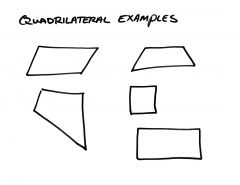
A four-sided polygon.
|
|
|
Parallelogram
|
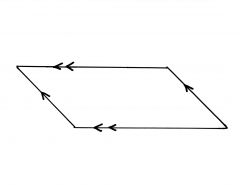
A quadrilateral with both pairs of opposite sides parallel.
|
|
|
If a quadrilateral is a parallelogram, then both pairs of opposite sides are...
|

congruent and parallel.
|
|
|
If a quadrilateral is a parallelogram, then both pairs of opposite angles are...
|
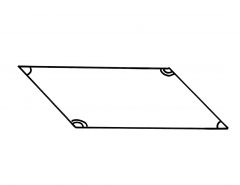
congruent.
|
|
|
If a quadrilateral is a parallelogram, then its diagonals...
|
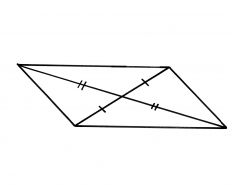
bisect each other.
|
|
|
If a quadrilateral is a parallelogram, then its consecutive angles are...
|
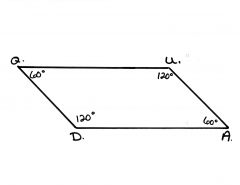
supplementary.
|
|
|
Parallelogram Opposite Sides Theorem:
|
Opposite sides of a parallelogram are congruent.
|
|
|
Parallelogram Opposite Angles Theorem:
|
Opposite angles of a parallelogram are congruent.
|
|
|
Parallelogram Consecutive Angles Theorem:
|
Consecutive angles of a parallelogram are supplementary.
|
|
|
Parallelogram Diagonals Theorem:
|
The diagonals of a parallelogram bisect each other.
|
|
|
Quadrilateral Parallel and Congruent Sides Theorem:
|
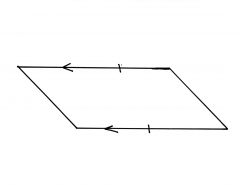
If one pair of opposite sides of a quadrilateral is both parallel and congruent, then the quadrilateral is a parallelogram.
|
|
|
Converse of the Quadrilateral Opposite Sides Theorem:
|
If both pairs of opposite sides of a quadrilateral are congruent, then the quadrilateral is a parallelogram.
|
|
|
Converse of the Quadrilateral Opposite Angles Theorem:
|
If both pairs of opposite angles of a quadrilateral are congruent, then the quadrilateral is a parallelogram.
|
|
|
Converse of the Quadrilateral Diagonals Theorem:
|
If the diagonals of a quadrilateral bisect each other, then the quadrilateral is a parallelogram.
|
|
|
Opposite, Parallel, Congruent Theorem:
|
If one pair of opposite sides of a quadrilateral is both parallel and congruent, then the quadrilateral is a parallelogram.
|
|
|
Rectangle Theorem:
|
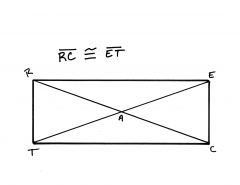
If a parallelogram is a rectangle, then its diagonals are congruent.
|
|
|
Converse of the Rectangle Theorem:
|
If the diagonals of a parallelogram are congruent, then the parallelogram is a rectangle.
|
|
|
If a quadrilateral is a rectangle, then opposite sides are ___________ and _____________.
|
congruent and parallel
|
|
|
If a quadrilateral is a rectangle, then opposite angles are ____________.
|
congruent
|
|
|
If a quadrilateral is a rectangle, then consecutive angles are ___________.
|
supplementary
|
|
|
If a quadrilateral is a rectangle, then diagonals are ______________ and ______________ each other
|
congruent and bisect
|
|
|
If a quadrilateral is a rectangle, then all four angles are ___________.
|
right (90 degrees)
|
|
|
Rhombus Diagonal Theorem:
|
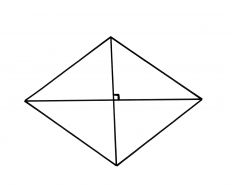
The diagonals of a rhombus are perpendicular.
|
|
|
Converse of the Rhombus Diagonal Theorem:
|
If the diagonals of a parallelogram are perpendicular, then the parallelogram is a rhombus.
|
|
|
Rhombus Angle Bisector Theorem:
|
Each diagonal of a rhombus bisects a pair of opposite angles.
|
|
|
If a quadrilateral is both a rhombus and a rectangle, it is a ____________.
|
square
|
|
|
Isosceles Trapezoid Base Angles Theorem:
|
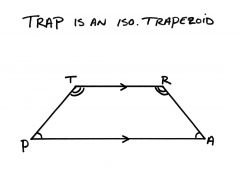
Both pairs of base angles of an isosceles trapezoid are congruent.
|
|
|
Isosceles Trapezoid Diagonal Theorem:
|
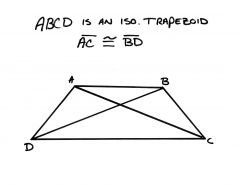
The diagonals of an isosceles trapezoid are congruent.
|
|
|
Trapezoid Median Theorem:
|
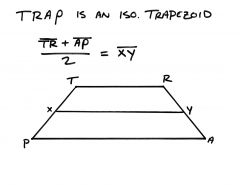
The median of a trapezoid is parallel to the bases, and its measure is one-half the sum of the measures of the bases.
|

